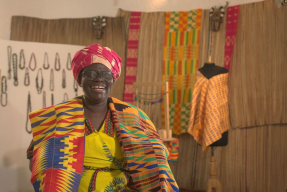Modernity in the Dominican Republic: La Capital vs. El Batey
March 1, 2012David Gorgani | KF 17 | Dominican Republic
I went to IKEA on Tuesday. I bought coat hangers, a laundry hamper, surge protectors, and (of course) Swedish meatballs.
In Santo Domingo, locally referred to simply as “La Capital,” it is an understatement to say that luxuries from back home are readily available. Sure, Taco Bell is considered by many to be fine dining and Hooters is a family establishment, but the sushi you find in La Capital is actually not half bad and Santo Domingo’s shiny new metro, probably its most outward attempt at showing off its modern side, is really quite impressive.
But this wonderland of IKEA, the Blue Mall, luxury car dealerships and international cuisine is the exception as opposed to the rule when viewed in the greater Dominican context. For example, here’s a photo of the batey I visited to meet with a Kiva Borrower last week:
Bateys are settlements that traditionally hosted migrant workers from Haiti during the sugar cane planting and harvesting seasons. Batey residents essentially lived as indentured servants, earning their housing and very small pay in exchange for hard labor. When the Dominican sugar cane industry contracted in the 1980s, most bateys became de facto full-time residences for undocumented immigrants that then found themselves without work.
Most Bateys lack basic services such as running water and electricity, and many of the immigrants’ children are denied schooling due to their parents’ residency status. And the most shocking part? There are literally Bateys in the capital, and many more within a 30 minute drive of the center of town. It’s no wonder so many Dominicans opposed the construction of Santo Domingo’s snazzy metro when there are so many that lack electricity, health services, schooling and running water in the city’s outskirts.
On the bright side, through increased attention from both the Dominican Government and the DR’s network of NGOs, living conditions in the bateys have improved significantly in the past decade. Schools are slowly being introduced, and pro bono health services are increasingly being offered to batey residents. Both of my MFI Field Partners – Esperanza International and ASPIRE – place the challenge of bateys and the general plight of the immigrant poor in the DR among their top priorities.
I’m sure this discrepancy between the modern metropolis and the poor, antiquated village is a phenomenon many of my fellow Fellows have also witnessed. I’d love to read about any experiences you’ve had in the comments section, KF17!
(Note: A great deal of this info was gleaned from Amnesty International - This is a great read if you want to know more about bateys and the Haitian population in the DR)
David Gorgani is a Kiva Fellow serving in the Dominican Republic, helping ASPIRE get started as a Kiva Field Partner, helping Esperanza International with borrower verifications, and attempting to learn salsa and merengue on the side.
PREVIOUS ARTICLE
Passport Series: Microfinance Adapts To Meet The Needs Of Salvadorans →NEXT ARTICLE
Social Performance in Action: One Acre Fund and the power of listening to farmers →
















